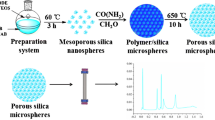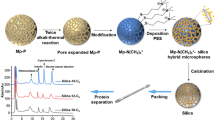Abstract
The optimization of mesoporous silica thin films by nanotexturing using oxygen plasma versus thermal oxidation was investigated. Calcination in oxygen plasma provides superior control over pore formation with regard to the pore surface and higher fidelity to the structure of the polymer template. The resulting porous film offers an ideal substrate for the selective partitioning of peptides from complex mixtures. The improved chemico-physical characteristics of porous thin films (pore size distribution, nanostructure, surface properties and pore connectivity) were systematically characterized with XRD, Ellipsometry, FTIR, TEM and N2 adsorption/desorption isotherm. The enrichment of low molecular weight proteins captured from human serum on mesoporous silica thin films fabricated by both methodologies was investigated by comparison of their MALDI-TOF MS profiles. This novel on-chip fractionation technology offers advantages in recovering the low molecular weight peptides from human serum, which has been recognized as an informative resource for early diagnosis of cancer and other diseases.
Similar content being viewed by others
References
Etzioni R, Urban N, Ramsey S, McIntosh M, Schwartz S, Reid B, Radich J, Anderson G, Hartwell L. The case for early detection. Nat Rev Cancer, 2003, 3: 243–252
Kulasingam V, Diamandis EP. Strategies for discovering novel cancer biomarkers through utilization of emerging technologies. Nat Clin Pract Oncol, 2008, 5: 588–599
Petricoin EF, Belluco C, Araujo RP, Liotta LA. The blood peptidome: A higher dimension of information content for cancer biomarker discovery. Nat Rev Cancer, 2006, 6: 961–967
Martin KJ, Fournier MV, Reddy GPV, Pardee AB. A need for basic research on fluid-based early detection biomarkers. Cancer Res, 2010, 70: 5203–5206
Yurkovetsky Z, Skates S, Lomakin A, Nolen B, Pulsipher T, Modugno F, Marks J, Godwin A, Gorelik E, Jacobs I, Menon U, Lu K, Badgwell D, Bast RC Jr, Lokshin AE. Development of a multi-marker assay for early detection of ovarian cancer. J Clin Oncol, 2010, 28: 2159–2166
Wulfkuhle JD, Liotta LA, Petricoin EF. Proteomic applications for the early detection of cancer. Nat Rev Cancer, 2003, 3: 267–275
Liotta LA, Ferrari M, Petricoin E. Clinical proteomics: Written in blood. Nature, 2003, 425: 905–905
Hanash SM, Pitteri SJ, Faca VM. Mining the plasma proteome for cancer biomarkers. Nature, 2008, 452: 571–579
Ebert MPA, Meuer J, Wiemer JC, Schulz HU, Reymond MA, Traugott U, Malfertheiner P, Röcken C. Identification of gastric cancer patients by serum protein profiling. J Proteome Res, 2004, 3: 1261–1266
Anderson NL, Anderson NG. The human plasma proteome: History, character, and diagnostic prospects. Mol Cell Proteomics, 2002, 1: 845–867
Davis MT, Auger PL, Patterson SD. Cancer biomarker discovery via low molecular weight serum profiling-are we following circular paths? Clin Chem, 2010, 56: 244–247
Antwi K, Hostetter G, Demeure MJ, Katchman BA, Decker GA, Ruiz Y, Sielaff TD, Koep LJ, Lake DF. Analysis of the plasma peptidome from pancreas cancer patients connects a peptide in plasma to overexpression of the parent protein in tumors. J Proteome Res, 2009, 8: 4722–4731
Tirumalai RS, Chan KC, Prieto DA, Issaq HJ, Conrads TP, Veenstra TD. Characterization of the low molecular weight human serum proteome. Mol Cell Proteomics, 2003, 2: 1096–1103
Righetti PG, Castagna A, Antonioli P, Boschetti E. Prefractionation techniques in proteome analysis: The mining tools of the third millennium. Electrophoresis, 2005, 26: 297–319
Jin W-H, Dai J, Li S-J, Xia Q-C, Zou H-F, Zeng R. Monolithic silica ODS capillary column with integrated nanoelectrospray ionization emitter for high efficient proteome analysis. J Proteome Res, 2005, 4: 613–619
Fountoulakis M, Juranville JF, Jiang L, Avila D, Röder D, Jakob P, Berndt P, Evers S, Langen H. Depletion of the high-abundance · plasma proteins. Amino Acids, 2004, 27: 249–259
Ramström M, Hagman C, Mitchell JK, Derrick PJ, Håkansson P, Bergquist J. Depletion of high-abundant proteins in body fluids prior to liquid chromatography fourier transform ion cyclotron resonance mass spectrometry. J Proteome Res, 2005, 4: 410–416
Dekker LJ, Bosman J, Burgers PC, van Rijswijk A, Freije R, Luider T, Bischoff R. Depletion of high-abundance proteins from serum by immunoaffinity chromatography: A MALDI-FT-MS study. J Chromatogr B, 2007, 847: 65–69
Castagna A, Cecconi D, Sennels L, Rappsilber J, Guerrier L, Fortis F, Boschetti E, Lomas L, Righetti PG. Exploring the hidden human urinary proteome via ligand library beads. J Proteome Res, 2005, 4: 1917–1930
Ferrari M. Cancer nanotechnology: Opportunities and challenges. Nat Rev Cancer, 2005, 5: 161–171
Cheng MM-C, Cuda G, Bunimovich YL, Gaspari M, Heath JR, Hill HD, Mirkin CA, Nijdam AJ, Terracciano R, Thundat T, Ferrari M. Nanotechnologies for biomolecular detection and medical diagnostics. Curr Opin Chem Biol, 2006, 10: 11–19
Hu Y, Fine DH, Tasciotti E, Bouamrani A, Ferrari M. Wiley Interdiscip Rev: Nanomed Nanobiotechnol, 2010, 9999: n/a
Riehemann K, Schneider SW, Luger TA, Godin B, Ferrari M, Fuchs H. Nanomedicine — challenge and perspectives. Angew Chem Int Ed Engl, 2009, 48: 872–897
Hu Y, Bouamrani A, Tasciotti E, Li L, Liu X, Ferrari M. Tailoring of the nanotexture of mesoporous silica films and their functionalized derivatives for selectively harvesting low molecular weight protein. ACS Nano, 2010, 4: 439–451
Bouamrani A, Hu Y, Tasciotti E, Li L, Chiappini C, Liu X, Ferrari M. Mesoporous silica chips for selective enrichment and stabilization of low molecular weight proteome. Proteomics, 2010, 10: 496–505
Gaspari M, Ming-Cheng Cheng M, Terracciano R, Liu X, Nijdam AJ, Vaccari L, di Fabrizio E, Petricoin EF, Liotta LA, Cuda G, Venuta S, Ferrari M. Nanoporous surfaces as harvesting agents for mass spectrometric analysis of peptides in human plasma. J Proteome Res, 2006, 5: 1261–1266
Geho D, Ming-Cheng Cheng M, Killian K, Lowenthal M, Ross S, Frogale K, Nijdam J, Lahar N, Johann D, Herrmann P, Whiteley G, Ferrari M, Petricoin E, Liotta L. Fractionation of serum components using nanoporons substuates. Bioconjugate Chem, 2006, 17: 654–661
Terracciano R, Gaspari M, Testa F, Pasqua L, Tagliaferri P, Cheng MM-C, Nijdam AJ, Petricoin EF, Liotta LA, Cuda G, Ferrari M, Venuta S. Fractionation of serum components using nanoporous substrates. Proteomics, 2006, 6: 3243–3250
Brinker CJ, Lu Y, Sellinger A, Fan H. Evaporation-Induced self-assembly: Nanostructures made easy. Adv Mater, 1999, 11: 579–585
Zhao D, Yang P, Melosh N, Feng J, Chmelka BF, Stucky GD. Continuous mesoporous silica films with highly ordered large pore structures. Adv Mater, 1998, 10: 1380–1385
Wan Y, Shi Y, Zhao D. Designed synthesis of mesoporous solids via nonionic-surfactant-templating approach. Chem Commun, 2007, 897–926
Lu Y, Ganguli R, Drewien CA, Anderson MT, Brinker CJ, Gong W, Guo Y, Soyez H, Dunn B, Huang MH, Zink JI. Continuous formation of supported cubic and hexagonal mesoporous films by sol-gel dip-coating. Nature, 1997, 389: 364–368
Yang ZL, Lu YF, Yang ZZ. Mesoporous materials: tunable structure morphology and composition. Chem Commun, 2009, 2270–2277
Gomez-Vega JM, Teshima K, Hozumi A, Sugimura H, Takai O. Mesoporous silica thin films produced by calcination in oxygen plasma. Surf Coat Technol, 2003, 169–170: 504–507
Zhang J, Palaniappan A, Su X, Tay FEH. Mesoporous silica thin films prepared by argon plasma treatment of sol-gel-derived precursor. Appl Surf Sci, 2005, 245: 304–309
Huang J, Ichinose I, Kunitake T, Nakao A. Preparation of nanoporous titania films by surface sol-gel process accompanied by low-temperature oxygen plasma treatment. Langmuir, 2002, 18: 9048–9053
Kros A, Gerritsen M, Sprakel VSI, Sommerdijk NAJM, Jansen JA, Nolte RJM. Biocompatibility of sol-gel matrices as biocoatings for implantable glucose sensors. Sens Actuators B, 2001, 81: 68–75
Yao B, Zhang L. Preparation and characterization of mesoporous titania gel-monolith. J Mater Sci, 1999, 34: 5983–5987
Author information
Authors and Affiliations
Corresponding author
Rights and permissions
About this article
Cite this article
Hu, Y., Peng, Y., Brousseau, L. et al. Nanotexture optimization by oxygen plasma of mesoporous silica thin film for enrichment of low molecular weight peptides captured from human serum. Sci. China Chem. 53, 2257–2264 (2010). https://doi.org/10.1007/s11426-010-4121-x
Received:
Accepted:
Published:
Issue Date:
DOI: https://doi.org/10.1007/s11426-010-4121-x




